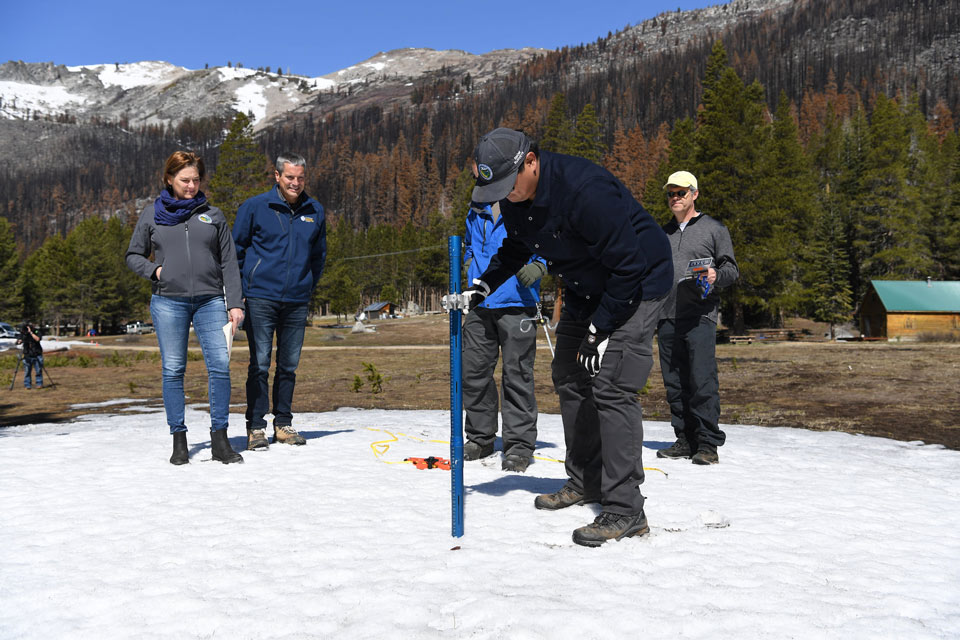
California Department of Water Resources (DWR) today conducted the fourth Phillips Station snow survey of the season. The manual survey recorded 2.5 inches of snow depth & a snow water equivalent of 1 inch, which is 4% of the April 1 average for this location. The statewide snowpack average is 38% of average.
The peak of the statewide snowpack was around March 8 at about 57% of average. Since March 8, the snowpack started to melt with 0.8 inches of snow water equivalent (SWE) lost in 10 days.
Updated with article.
April 1, 2022 - SACRAMENTO, Calif. – The Department of Water Resources (DWR) today conducted the fourth snow survey of the season at Phillips Station. Following three straight months of record dry conditions, the manual survey recorded just 2.5 inches of snow depth and a snow water equivalent of one inch, which is four percent of average for this location for April 1. Statewide, the snowpack is just 38 percent of average for this date.
The snowpack at Phillips Station has plummeted since the beginning of the year. On December 30, the snowpack stood at 202 percent of normal for that date. In a normal season, the snowpack depth would be about five feet deep at this time of year.
The snow water equivalent measured at the snow survey shows the amount of water contained in the snowpack and is a key component of DWR’s water supply forecast, including anticipated runoff into the state’s reservoirs.
April 1 is typically when the snowpack is at its highest, however the statewide snowpack likely peaked in early-March this year and the Northern Sierra snowpack peaked in mid-January.
“The conditions we are seeing today speak to how severe our drought remains. DWR has been planning for the reality of a third dry year since the start of the water year on October 1,” said DWR Director Karla Nemeth. “While DWR has made significant investments in forecasting technology and other tools to ensure we make the most out of the snowmelt we do receive, water conservation will remain our best tool in the face of this ongoing drought and the statewide impacts of a warming climate. All Californians must focus on conserving water now.”
Dry conditions are impacting every region of the state, as the Northern, Central, and Southern Sierra snowpacks are all standing just above 28 percent to 43 percent of average for this date.
“With the exceptionally dry conditions during the past three months, our latest statewide snowmelt forecasts are only 44 percent of average,” said Sean de Guzman, Manager of DWR’s Snow Surveys and Water Supply Forecasting Unit. “While today usually marks the typical peak of the state’s snowpack, this year’s snowpack likely peaked in mid-January in the Northern Sierra. Most of the snow accumulation this year came from just two storms in December that were followed by the driest January and February on record in the Sierra, and unfortunately March only brought a few weak systems.”
“Today’s snow survey reinforces what we’ve all observed – California just experienced the driest three months on record, and drought is worsening throughout the West,” California Secretary for Natural Resources Wade Crowfoot said. “Climate-driven water extremes are part of our reality now, and we must all adapt and do our part to save water every day.”
While the state continues to take necessary actions to help extend the state’s existing water supply, all Californians are also encouraged to do their part now to conserve as much water as possible to make it last. Governor Newsom has called on all Californians to voluntarily reduce their water use by 15 percent with simple measures to protect water reserves. Earlier this week, the Governor called on local water suppliers to move to Level 2 of their Water Shortage Contingency Plans, which require locally-appropriate actions that will conserve water across all sectors, and directed the State Water Resources Control Board to consider a ban on the watering of decorative grass at businesses and institutions. Individuals looking for information about reducing water consumption at home can visit SaveOurWater.com for water-wise tips.

Image of the April 1, 2022 snow survey at Phillips Station.
Additional Resources
- Snowpack readings (View readings for current regional snowpack and historical snowpack comparison)
- CDEC precipitation data (View current charts for the Northern Sierra 8-station index for updated rainfall readings in the critical northern portion of the state, as well as the San Joaquin 5-station index and Tulare Basin 6-station index.)
- More information on DWR’s Airborne Snow Observatory Program
Source: CA. DWR Photo credit: DWR
Related: California Third Snow Survey of 2021-2022 Falls Well Below Average Following Consecutive Dry Months - Statewide the Snowpack is 63% of Average for March 1








